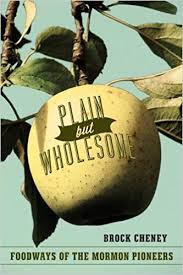Articles/Essays – Volume 46, No. 2
Toward a Mormon Culinary History | Brock Cheney, Plain but Wholesome: Foodways of the Mormon Pioneers
Editor’s Note: This article has footnotes. To review them, please see the PDF below.
Brock Cheney’s history of Mormon food, Plain but Wholesome: Foodways of the Mormon Pioneers does much to fill a surprising lacuna in Mormon history. Although a number of books on food and religion exist, there is little academic exploration of the role that food played in the shaping and development of Latter-day Saint culture. While Cheney’s work reads a bit like a church potluck, lacking the unity of a well-constructed menu, it nonetheless provides interested readers and academics alike with a variety of tempting morsels to inspire further exploration.
Plain but Wholesome explores a variety of culinary-related tropes. The book begins with the material artifacts and culinary memorabilia that allow one to peer back in time, and then travels through the practices of searching for, gathering, planting, harvesting, preserving, and producing food. Structurally, each of the main chapters begins with an anecdote or story, and then builds off one of the themes previously mentioned. These vignettes seek to situate readers in the time period and topic to be explored, and are followed by an interesting collection of historical facts, photo graphs, and recipes, drawing extensively from the archival resources of the Daughters of Utah Pioneers.
Cheney deserves accolades for re-examining this underutilized resource, and for recognizing that much of culinary history, as women’s work, is found not necessarily in written record but more often in the historical silence created when tacit knowledge is passed from mother to daughter. He deftly justifies his source selection, and quite aptly demonstrates the worth of re-examining partial or provenance-less records.
Unfortunately, Plain but Wholesome stumbles in its attempts to combine interesting tidbits with larger “so-whats.” Cheney is not an academic historian, as the book demonstrates by a lack of historiography or extensive theoretical engagement. For non-academics, this will be refreshing. For academic readers, this lack will occasionally frustrate, especially as powerful opportunities for linking this research with non-Mormon scholarship are missed. The framing themes of “geographical isolation, poverty, and ethnic tradition” (170) that the author sees as central to the Mormon food experience both on the trail and once settled in Utah fade under the shower of interesting facts provided. A stricter editorial hand could have easily effaced this final critique.
Similarly, certain concepts, potentially quite interesting, are glossed over in the rush to get to the next fact or idea. For example, in speaking of baking and sweets, Cheney notes that Christiana Thompson Galli’s “Sweet Cream Cake” provided her with a “distinct identity, separate from the younger second wife” when her husband entered into a polygamous marriage (147). Given the well-established explorations of food and identity already present in both lay and academic work, further examination of how Christiana’s cake allowed her to create a distinct identity would have allowed Cheney to direct novice readers to already existing works while also providing a unique contribution to the much smaller literature on Mormon women and identity.
However, Cheney’s failure to adequately engage with the many opportunities to “go deeper” in favor of “go broader” provides other researchers with a treasure trove of new research directions. His discussion of the proactive role Mormon pioneers, primarily women, played in collecting and promoting the growth of wild yeast (61–73) becomes especially interesting when juxtaposed with accounts about the viticulture and beer brewing that characterized early pioneer life (160–69). One can easily imagine a variety of research questions growing out of that juxtaposition alone: what role did gender play in the “shepherding” of yeast cultures? How did culinary discourse on the Mormon frontier change as church leaders increasingly codified the Word of Wisdom?
Despite the minor failings of Plain but Wholesome, the book is well worth reading on a chapter-by-chapter basis. I personally envision a few groups that would especially benefit from this book. First, Plain but Wholesome would work well in an undergraduate or advanced high-school course examining historical research in general or the history of Utah in particular. The introduction nicely demonstrates the need for primary source materials, and does not shy away from showing the difficulties of putting together a historical narrative—both useful but often overlooked starting points for teaching history to novices. Additionally, the anecdotes that head each chapter allow younger readers to easily enter the drier historical materials. Second, Plain but Wholesome should appeal to a variety of scholarly fields, primarily for the number of interesting questions it raises. Finally, the book should appeal to a much wider readership just interested in learning more about the pioneer experience or in understanding the ways that early Saints did and did not interact with the wider world. From the opportunity to try one’s hand at creating a bit of living history through the recipes scattered throughout the book to the site-specific histories that may encourage a bit of personal sleuthing, Plain but Wholesome provides a wide range of ways to personally engage with history.
Brock Cheney. Plain but Wholesome: Foodways of the Mormon Pioneers. Salt Lake City, Utah: University of Utah Press, 2012. Paper: $19.95. ISBN: 978–1607812081.


 Back to full Issue
Back to full Issue

